AustLit
The material on this page is available to AustLit subscribers. If you are a subscriber or are from a subscribing organisation, please log in to gain full access. To explore options for subscribing to this unique teaching, research, and publishing resource for Australian culture and storytelling, please contact us or find out more.
Latest Issues
AbstractHistoryArchive Description
'The book presents us with some life-like scenes in the Australian bush, and with sensations enough to satisfy the taste of the confirmed novel reader. The characters are powerfully drawn, and the plot is worked out with truth and force and judgement.
'The chief character is a philanthropist doctor in Melbourne, whose practice gives him only too thorough an insight into the state of destitution, deprivations, and indecent crowding in which the 'submerged' vegetate in the slums of a great city.'
Source: Rev. of The New Arcadia, by Horace Tucker. Dungong Chronicle, 11 May 1894.
Notes
-
Epigraph: 'The old order changeth, yielding place to new...Lest one good custom should corrupt the world.'
-
This work has been digitised by the Reason in Revolt project.
Publication Details of Only Known VersionEarliest 2 Known Versions of
Works about this Work
-
Futures without Financial Crises : Utopian Literature in the 1890s and 1930s
2009
single work
criticism
— Appears in: Continuum : Journal of Media & Cultural Studies , vol. 23 no. 6 2009; (p. 839 - 853) 'Australian utopian fiction of the 1890s and 1930s reflects the traumatic impact of the economic crises of these decades and expresses desire to avoid the insecurities of capitalism. There are significant differences, however, in the imaginative reach of the utopias devised in the 1890s and those formulated in the 1930s. In Australia in the 1890s, the possibilities for progress and perfection were varied. Unionism, socialist legislation, the formation of ideal communities based on socialist or anarchist principles, militant forms of protest, attempts to inaugurate direct rather than mere representative democracy were some of the various strategies pursued in this decade that promised a better world. The methods depicted in the utopian writings of the 1890s for achieving ideal societies are as diverse as the real politically radical currents of the time. By the 1930s, the starkly singular conception of emancipation offered by the Soviet model dominates the imagination of those who wrote of better futures. The utopian literature of the 1930s is thus diminished by its fascination with an alleged model of perfection in the real world. The differences between the utopian literatures of two decades undergoing similar upheavals confirms Darko Suvin's observation that the parameters of utopian imagination are produced by the particular radical milieux around those who dare to dream of alternatives.' (Author's abstract) -
Visions of the Nineties
1987
single work
criticism
— Appears in: Journal of Australian Studies , May no. 20 1987; (p. 12-22) -
New Arcadias : Co-Operative Movements of the Nineties
1985
single work
review
— Appears in: Margin , no. 15 1985; (p. 19-24) -
Literature. "The New Arcadia"
1894
single work
review
— Appears in: The Sydney Mail , 5 May vol. 57 no. 1894 1894; (p. 904)
— Review of The New Arcadia : An Australian Story 1894 single work novel
-
Literature. "The New Arcadia"
1894
single work
review
— Appears in: The Sydney Mail , 5 May vol. 57 no. 1894 1894; (p. 904)
— Review of The New Arcadia : An Australian Story 1894 single work novel -
New Arcadias : Co-Operative Movements of the Nineties
1985
single work
review
— Appears in: Margin , no. 15 1985; (p. 19-24) -
Futures without Financial Crises : Utopian Literature in the 1890s and 1930s
2009
single work
criticism
— Appears in: Continuum : Journal of Media & Cultural Studies , vol. 23 no. 6 2009; (p. 839 - 853) 'Australian utopian fiction of the 1890s and 1930s reflects the traumatic impact of the economic crises of these decades and expresses desire to avoid the insecurities of capitalism. There are significant differences, however, in the imaginative reach of the utopias devised in the 1890s and those formulated in the 1930s. In Australia in the 1890s, the possibilities for progress and perfection were varied. Unionism, socialist legislation, the formation of ideal communities based on socialist or anarchist principles, militant forms of protest, attempts to inaugurate direct rather than mere representative democracy were some of the various strategies pursued in this decade that promised a better world. The methods depicted in the utopian writings of the 1890s for achieving ideal societies are as diverse as the real politically radical currents of the time. By the 1930s, the starkly singular conception of emancipation offered by the Soviet model dominates the imagination of those who wrote of better futures. The utopian literature of the 1930s is thus diminished by its fascination with an alleged model of perfection in the real world. The differences between the utopian literatures of two decades undergoing similar upheavals confirms Darko Suvin's observation that the parameters of utopian imagination are produced by the particular radical milieux around those who dare to dream of alternatives.' (Author's abstract) -
Visions of the Nineties
1987
single work
criticism
— Appears in: Journal of Australian Studies , May no. 20 1987; (p. 12-22)
Last amended 27 Jun 2018 12:04:09
Subjects:
- Melbourne, Victoria,
- Victoria,
- ca. 1890-1894
Export this record




